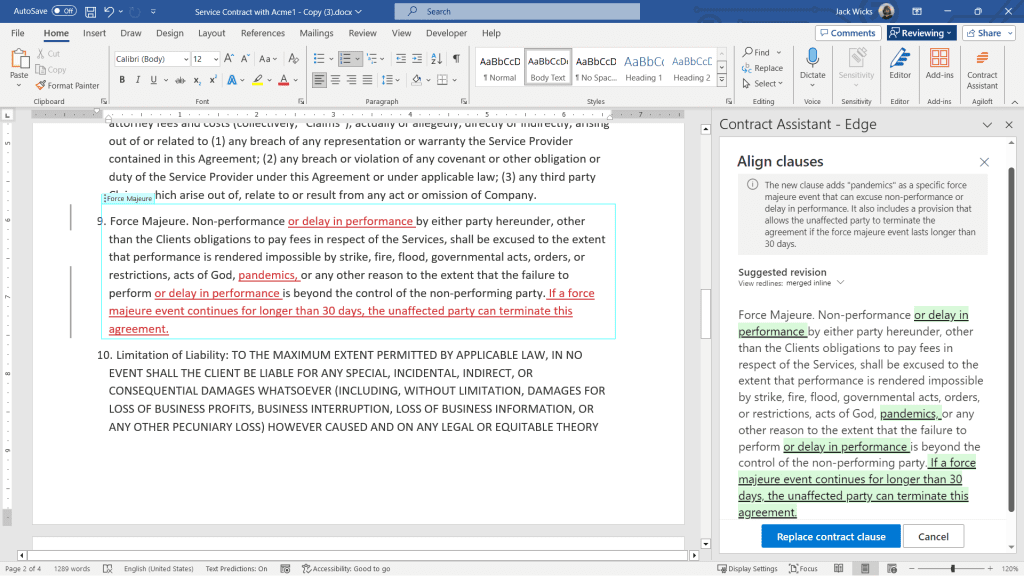

Andy Wishart, Chief Product Officer at Agiloft, commented, “We are thrilled today to announce new generative AI capabilities for 2024 that build onto our existing AI Platform. With this release, we are addressing the all-too-common problem legal and contracting professionals see when negotiating contracts: excessive and endless redlining between parties.
“This new capability employs generative AI to understand approved clauses, review third-party contract language for areas of misalignment, and then compose redlines that marry third-party contract language with legal’s preferred phrasing. This greatly reduces the back-and-forth negotiations between parties, providing an express route to contract execution.”
What is Gen AI Redlining
Enterprise Times spoke to Wishart about the announcement. The announcement does little to explain how it fits into the platform. I asked Wishart for clarification.
He said, “It is unified into the Agiloft platform and is surfaced through our existing Agiloft contract assistant for Microsoft Word. That is the tool that sits inside Microsoft Word and provides negotiation capabilities today for our customers, like identifying clauses through our AI platform. Connecting those clauses in a document to clauses in a clause library.
“The new capability that we’re delivering is then being able to align clauses from the clause library to clauses within the document. So it’s surfaced inside our existing tooling within Microsoft Word.”

Users will also have the option of creating new clauses using Gen AI that match their needed terms and closely conform to the text of the contract under negotiation. Initially, the platform is available in English. Agiloft is using a fine-tuned GPT 3.5 model running in Azure.
I asked Wishart what jurisdictions it works in. He replied, “The fine-tuning that we’ve done is around US English commercial contracting. We see good performance on English language documents in US, Canadian and also UK jurisdictions, so we’ll be launching this both in North America and also in Europe.”
In selecting Azure, Wishart believes that customers understand that their data is held securely by Microsoft. Also, Agiloft is not benefitting from the data; as Wishart explained. Agiloft is not using the data to improve its product. It is only used by Generative AI for their benefit.
I also asked Wishart about the Agiloft approach to explainable AI. And how they are explaining to customers how it sources the results. He replied, “When we take a clause that is in the current contract and align that with a clause in the clause library, what is produced is a red line suggestion coming back from the Gen AI redlining capability, together with a summary. We’re using Gen AI to create a summarization of the changes that are suggested. Users can review the summary as well as the redline itself.”
Eric Laughlin, CEO at Agiloft, commented, “With this release, our team has brought the transformative technology of Generative AI directly into contracting, freeing up legal and contract teams to streamline negotiations by capitalizing on the language they have already approved to get deals done and accelerate the business.”
Building trust
Laughlin also said, “Our goal is to use AI as a force multiplier to assist our customers in solving their biggest contracting challenges and ultimately improve their businesses. We see AI as an enabling technology that will supplement human decision-making, not replace it. We go to great lengths to ensure that our customers retain control over their work product and build trust over time in AI assistance.”
That trust may not be easy to achieve from Lawyers, especially if they feel threatened by AI. I asked Wishart how long he believed it would take to build that trust.
He replied, “Initially, as we’re launching this capability and making it available to early adopters next week. We’re giving those early adopters free access to the tool throughout the next couple of months. We’ll be making this available broadly, more generally, to all of our customers in February. Every customer is going to be different and a different part in their maturity overall, with CLM.
“Those customers that have made investments in building out their standard clauses in their clause library are already using some of our tooling in negotiations and are going to get greater value from this tooling quicker. I think it could be even an immediate benefit to those customers.
“The trust will come through them continuing to use it to see that Gen AI is providing substantive, real results in aligning clauses between third-party agreements and their standard clauses. That trust should be built up really quickly over the next couple of months.
“Longer term, our view is, and I think the point that Eric is making there within the press release, is that our approach is to create pragmatic, well-tested, Gen AI-powered capabilities that are there to assist users.
“That has been a fundamental premise of all of the AI capabilities that we’ve delivered, that there is a review step. Users are in control. Gen AI is not all redlining and sending out the red line to the other party, but it is making suggestions that the lawyer or the contract specialists can then apply to the documents. They remain in control.”
When is it coming?
While GenAI Redlining has been with a few customers already, it goes into the early access program this week. Wishart revealed that the plan is for a general release as early as February. I asked Wishart whether customers who want to adopt the solution should consider building their standard clause library in preparation.
He answered, “There is a benefit to having created standard clause libraries in the majority of customers that is part of their standard implementation for CLM. However, there is still a capability in the tool which enables them to ask Gen AI to revise a clause and produce red lines without having clauses within their clause library.”
Redlining Gen AI is now included as part of the Agiloft AI Platform that was first announced in August. There is no additional cost for those organisations that already use the AI platform, including the AI Trainer it launched last year.
Agiloft will continue working with the early adopter, using their insights to build and improve these and future features. While the intent is to save time and speed up processes, it is still too early in the release cycle to understand the difference it can make.
However, I asked Wishart what other benefits customers are seeing. He replied, “Early customers are seeing even more reason why they need to adopt standards within their clause library. The tooling is then really helping reduce those cycle times.
“It is driving greater awareness of the need to have well-managed clauses, to have those clauses tagged and in the clause library as standard and fall back, with guidance around it, because that’s going to make the experience even more powerful.
“A couple of other things that we know is occasionally, when we’re asking Gen AI to make a revision on a clause, it might correct some grammar and spelling mistakes in the clause as well. So there are some smaller interim benefits as well on that revision and having that pair of Gen AI eyes on the clause.”
What is on the roadmap?
Wishart answered, “We have another release coming in May. We’ve got some exciting new capabilities. Within our Gen AI roadmap, we’re looking at things like search again, building on top of Convo AI that we delivered around this time last year. We are also looking at areas where we can bring the ethos of the Agiloft platform, that flexibility, that configurability to Gen AI as well. More details will come as we get closer to that May release.”
Agiloft is working directly with early adopters to build and improve this and other features that enable connected, intelligent, and autonomous contracting processes so companies can unlock the value of contract data and accelerate business.
I asked Wishart whether the Redlining capability learns and updates the standard clauses at all.
“Once a red line has been made into a clause on an individual contract, we are tracking that the red line has been made and that deviation exists. Then, it’s a process of aggregating across all of the contracts to identify clauses that are being negotiated the most. The highlighting of an optimization that could be made to the underlying standard clauses to reduce the amount of negotiation in the future.
“We have clause tracking capability already today within Agiloft that supports aggregation across all of those clauses within the contracts. It can help a legal ops user identify changes that should be made to standard clauses or standard templates.
“We do believe that there could potentially be a role of Gen AI in streamlining that further. That’s not part of the redlining in a release today. However, we do see the potential for that. That is one of the use cases that we’re pursuing and looking at on the roadmap.”
Enterprise Times: What does this mean
Agiloft is taking a steady approach to rolling out its Generative AI capability. Rather than over-promising, this new solution enhances the existing platform. It also gives customers surety that their data is held safely in a trusted cloud vendor. Customers should welcome the new Redlining, which offers the promise of considerable time-saving in any contract negotiation process.
Agiloft should aim to get some metrics to demonstrate its value to customers and prospects. Even an early adopter customer quote would have added strength to this announcement. Hopefully, when the Gen AI redlining is made generally available in February, it should have more comments and more data. With features due to arrive in May, it could be an exciting year for Agiloft.

























